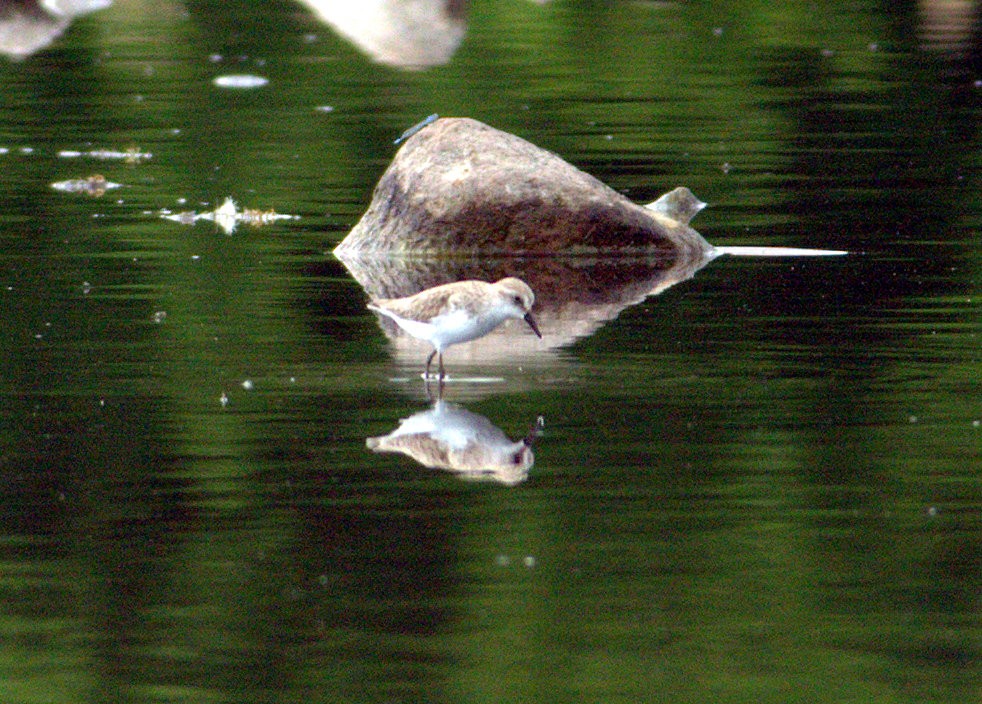Semipalmated Sandpiper
A species of Calidris Scientific name : Calidris pusilla Genus : Calidris
Semipalmated Sandpiper, A species of Calidris
Botanical name: Calidris pusilla
Genus: Calidris
Description
It is a small sandpiper, 13–15 cm (5.1-5.9 in) long and weighing around 20-32 g (0.7-1.1 oz). Wingspan ranges from 13.8-14.6 in (35-37 cm). Adults have black legs and a short, stout, straight dark bill. The body is dark grey-brown on top and white underneath. The head and neck are tinged light grey-brown. This bird can be difficult to distinguish from other similar tiny shorebirds, in particular the western sandpiper; these are known collectively as "peeps" or "stints". 
Size
15-18 cm (6-7 in)
Colors
Brown
Black
Gray
White
Life Expectancy
16 years
Nest Placement
Ground
Clutch Size
4 eggs
Incubation Period
1 brood
Number of Broods
19 - 22 days
Feeding Habits
Semipalmated Sandpiper primarily consume small invertebrates such as arthropods, amphipods, mollusks, and marine worms. They forage in shallow waters, using touch and vision to peck and probe rapidly on the surface for prey, especially focusing on aquatic insects and small crustaceans.
Habitat
Semipalmated Sandpiper are typically found in the southern tundra regions of Canada and Alaska, favoring habitats near water for breeding. They prefer nesting on the ground, in environments characterized by a mixture of sedges, grasses, mosses, willows, birch, and berry plants. Their breeding areas are typically low tundra not far from marshes or ponds and rarely devoid of vegetation. During migration, they congregate on mudflats and lakeshores in shallow water areas, which serve as crucial feeding grounds where they forage for aquatic insects and crustaceans.
Nest Behavior
After males create multiple scrapes, the female selects one to line and lay eggs. Nesting is closely tied to the availability of wetland habitats. Both parents share duties in egg incubation and care for the young after hatching.
Nest Characteristics
Semipalmated Sandpiper's nests are typically scrapes made by males near ponds on small hummocks, with low plant cover like willow or sedge. Females select and line these with grass, moss, and leaves, forming a cup about 2.2 inches wide and 1.8 inches deep.
Dite type
Aquatic invertebrate eater
People often ask
Migration Overview
They are long distance migrants and winter in coastal South America, with some going to the southern United States and the Caribbean. They migrate in flocks which can number in the hundreds of thousands, particularly in favoured feeding locations such as the Bay of Fundy and Delaware Bay. This species is a rare but regular vagrant to western Europe. Although very numerous, these birds are highly dependent on a few key stopover habitats during their migration, notably Mary's Point and Johnson's Mills along Shepody Bay, an arm of the Bay of Fundy. During the months of July and August, the Nature Conservancy of Canada runs an information center about these shorebirds in Johnson's Mills, New Brunswick. 
General Info
Feeding Habits
Bird food type
Sounds
Call
Recording location: United States
Song
Recording location: United States
Call
Recording location: Venezuela
Behavior
Semipalmated Sandpiper are known for their cyclical daily activities which often correlate with tidal patterns. They typically forage in groups, pecking and probing the wet sand for invertebrates. During breeding season, males display unique territorial behaviors, including aerial displays and distinctive motorboating calls to attract mates and deter rivals. Habitually, they show fidelity to their previous year's nesting grounds. Their interaction with the habitat is marked by migration-linked feeding frenzies to store energy for long flights.
Species Status
Not globally threatened.
Scientific Classification
Phylum
Chordates Class
Birds Order
Shorebirds Family
Sandpipers Genus
Calidris Species
Semipalmated Sandpiper 